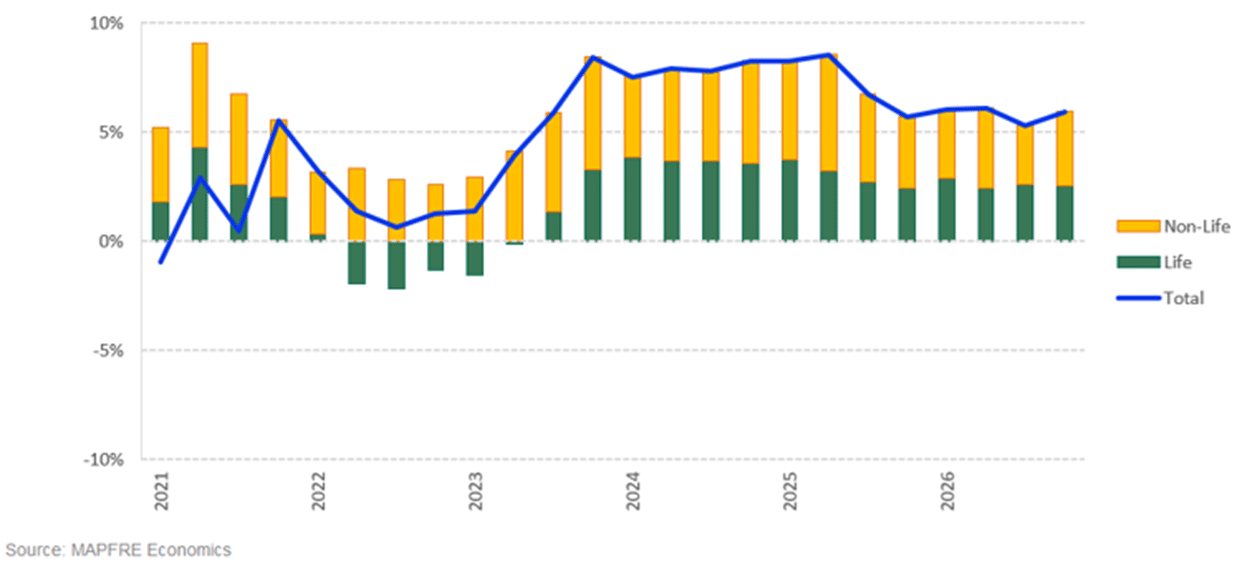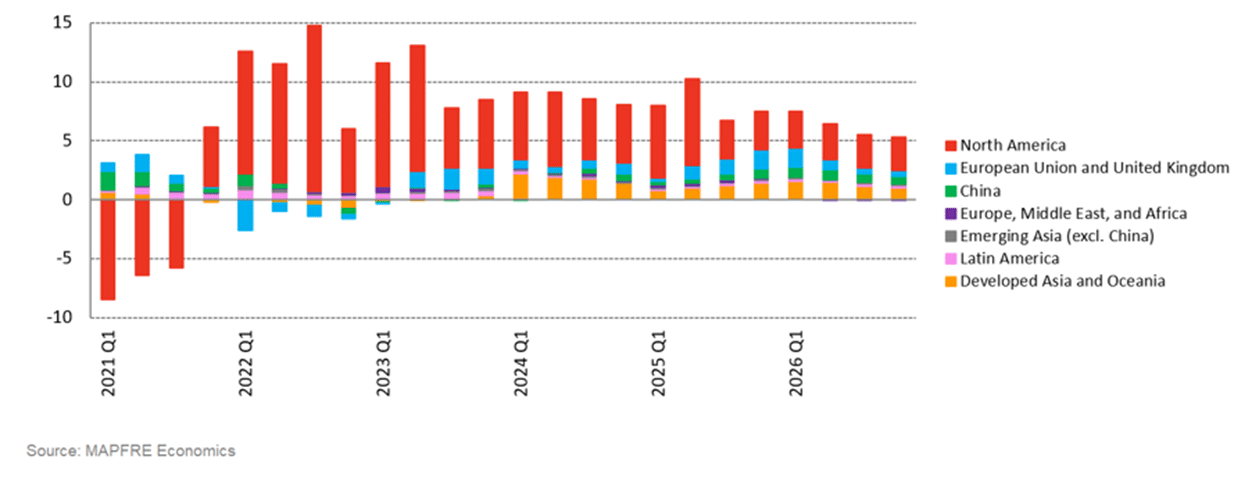Industry Outlook for the Insurance Market (Q4 2025)
Author: MAPFRE Economics
Summary of the conclusions of the:
MAPFRE Economics report
2025 Economic and Industry Outlook: Fourth-Quarter Forecast Update
Madrid, Fundación MAPFRE, November 2025
Global economic environment
The tightening of U.S. trade policy in the form of new tariffs, coupled with a persistent environment of geopolitical and regulatory uncertainty, is reshaping global trade patterns and causing potential disruptions in international logistics. In fact, international trade growth is showing signs of slowing down, reflecting the return of import flows to normal after the temporary surge seen at the start of the year, driven by advanced purchases in anticipation of further tariff increases. Likewise, in advanced economies, the disinflation process appears to have temporarily stalled. In particular, the United States is experiencing a resurgence in core goods inflation, driven by rising production costs and domestic demand that remains resilient, despite the previous tightening of monetary conditions.
A temporary upturn in U.S. inflation is also expected in 2026, attributable to the second-round effects of higher tariffs, expansionary fiscal policy, and the depreciation of the U.S. dollar—factors that could reignite imported inflationary pressures.
This has led to the global economic activity forecast remaining stable and at moderate levels. Despite a rebound in global GDP during the first half of 2025, this momentum is not expected to be sustained in the medium term.
Nominal global growth in insurance premiums (2021–2026)
The dynamics of nominal growth in insurance premiums worldwide (see Figure 1) suggest that the recovery of the Life and Non-Life sectors will be uneven. This is influenced by factors such as macroeconomic volatility, exchange rate fluctuations, and the impacts of inflation and global monetary policies. Looking ahead, the global insurance market is expected to see nominal stability, following a period of high volatility. Forecasts foresee average annual growth of 6.3% for the Life segment and 5.5% for the Non-Life segment.
Chart 1. Global: nominal premium growth
(annual nominal growth in USD, %)
Contribution of insurance lines to premium growth
As for contributions to premium growth at a global level, broken down by Life and Non-Life lines starting in the first quarter of 2021 and running until the end of 2026 (see Chart 2), it can be seen that while Life has an average contribution of 2.7%—in a year where interest rates remained low, affecting the yields obtained on insurers’ investments and reducing the appeal of traditional savings products—Non-Life makes an average contribution of 3.96%, driven by the strong global economic recovery and the increase in demand for protection.
In contrast, in 2022, the Life insurance sector made small or negative contributions, primarily on account of the cost-of-living crisis (resulting in a decrease in the purchase of these types of savings products) and the continued rise in interest rates to combat inflation. This resulted in traditional Life insurance savings products losing appeal compared to other investment options with higher returns, such as bonds and other fixed-income instruments. However, Non-Life products made positive contributions throughout the year, with premium rates rising in response to higher inflation and increased claims costs. This increase could be seen in key Non-Life segments such as auto, health, and property insurance.
In 2023, Life insurance made a negative contribution during the first quarters of the year, while in the second half, the volume of Life insurance premiums worldwide experienced a significant recovery in nominal terms, although growth in real terms was much more moderate. This recovery represented a positive change from the real contraction observed in 2022, as insurers saw their fixed-income investments offer higher returns and were more appealing to buyers. Due to the cost of insurance, insurance rates rose across the board, leading to an increase in Non-Life insurance premium volumes in both nominal and real terms, recovering from the slowdown seen in previous years.
In contrast to the contraction seen in 2022 and the moderate recovery in 2023, global Life insurance premium volumes experienced strong growth in 2024, driven primarily by the attractiveness of savings products and annuities in a high-interest-rate environment. This growth was particularly noticeable in advanced markets and was complemented by the expansion in emerging markets. Global Non-Life insurance premium volume continued to experience robust and widespread growth in 2024, driven primarily by the continued increase in premium rates in response to persistent inflation in the cost of claims and the tightening of reinsurance markets, as well as strong demand for protection.
Looking at 2025 and 2026, premium volume growth in both insurance segments is expected to slow due to the global economic slowdown, driven by geopolitical uncertainty and trade tensions. However, contributions for the 2025–2026 period will remain positive, although the Non-Life market will make a larger percentage contribution on average (3.6%) than the Life segment (2.8%).
Chart 2. Global: contribution of insurance lines to premium growth
The contribution to the growth of Life premiums by economic regions (see Chart 3) is particularly diverse and volatile depending on the regions in question. An analysis of each of these is provided below:
Chart 3. Global: contribution to Life premium growth by economic regions
North America is consolidating its position as the primary driver of expansion in the global Life insurance market, consistently contributing to overall growth even during periods of high economic volatility. This performance reflects the structural strength of the U.S. market, fueled by a macroeconomic environment in which fiscal policies support disposable income and a more accommodative monetary policy during certain phases of the economic cycle. In addition, the high penetration of insurance policies with a savings and retirement component has acted as an anchor of financial stability for households, encouraging the accumulation of insurance assets. Against this backdrop, the resilience of the sector in North America is not only linked to its ability to adapt to interest rate fluctuations, but also to the depth of its capital markets and the countercyclical role that Life insurance plays as a tool for planning and wealth management.
Both the European Union and the United Kingdom make a clearly contractionary contribution to the overall dynamism of Life insurance premiums, especially between the first quarter of 2022 and the third quarter of 2023. This drop can largely be attributed to the tightening of monetary policy, with sustained increases in official interest rates, which has increased the profitability of alternative financial assets and reduced the relative appeal of savings insurance products. This has been compounded by a more demanding regulatory environment (particularly Solvency II and sustainability), as well as a structural shift in household preferences towards more liquid investment instruments with shorter time horizons. When combined, these factors have generated a shift of financial savings away from insurance, limiting premium growth and negatively impacting the sector’s overall growth.
China has maintained a decisive position in the global Life insurance market, making a sustained contribution to global growth, albeit with a trajectory that has seen periods of volatility. Following a period of expansion driven by increased disposable income and the consolidation of the urban middle class, the Asian giant’s contributions started to slow down from 2022 onward, in line with the structural slowdown in its potential GDP, the deterioration of the real estate sector, and weaker private consumption. These factors have limited demand for savings and long-term insurance products. However, the recovery seen since the second half of 2024 suggests that the sector is gradually rebounding, supported by targeted fiscal stimulus policies, a more accommodative monetary environment, and renewed interest in wealth protection and management instruments amid greater economic uncertainty.
The performance of the emerging Asia region, excluding China, is favorable but remains limited in its contribution to global Life insurance premium growth. This reflects the coexistence of high expansion potential, driven by rising per capita income, demographic dynamism, and the increasing formalization of employment, with structural limitations stemming from limited financial depth and low insurance density. In many of these markets, the lack of long-term savings instruments, low levels of financial literacy, and the limited presence of digital distribution channels restrict the potential of Life insurance as a tool for planning and capital accumulation. However, the trend is clearly upward: increasing access to banking services, the expansion of microinsurance, and the adoption of more robust regulatory frameworks are laying the groundwork for a gradual shift toward penetration levels typical of more advanced economies.
The structural weight of advanced economies of Asia and Oceania (with Japan as the dominant player in the Life insurance segment) within the global market remains significant, although their contribution weakened somewhat during 2022. This negative performance is associated with a combination of historically low interest rates, significant demographic aging, and the maturity of the insurance market itself; these factors limit premium growth and reduce the technical profit margin. However, their contribution started to gradually recover from 2023 onward, driven by monetary easing, the search for products with a higher financial return, and the digitalization of distribution channels. In Japan, increased demand for Life insurance and retirement savings reflects rational household behavior in the face of macroeconomic uncertainty and financial market volatility.
Overall, positive growth is projected across all regions for 2025–2026, with the United States, the EU, the UK, and China being the main contributors to global Life insurance growth. This period will also see the regional rebalancing of growth and the increasing alignment of Life insurance and savings and investment products, against a backdrop where innovation, sustainability, and financial education will be crucial for sustaining the development of the global insurance sector.
As regards Non-Life premium growth by economic region (see Chart 4), the breakdown is as follows:
Chart 4. Global: contribution to Non-Life premium growth by economic region
The United States has solidified its position as the primary driver of global Non-Life insurance premium growth throughout the period in question. While its contribution to growth was negative during the first three quarters of 2021, it subsequently made a positive and sustained contribution, playing a significant role in the expansion of the global market in the following years. This performance reflects both the size and sophistication of the U.S. insurance market and the country’s macroeconomic recovery following the pandemic, supported by expansionary fiscal and monetary policies. What’s more, the rebound was boosted by upward adjustments to rates for commercial lines, increased awareness of exposure to extreme climate risks, and the adoption of more prudent underwriting strategies that incorporate advanced risk assessment models.
The contribution of the European Union and the United Kingdom to the growth of Non-Life insurance premiums has been varied. During the first and second quarters of 2022, they saw significant negative impacts associated with the post-pandemic economic slowdown, geopolitical uncertainty stemming from the war in Ukraine, high inflation, and the resulting erosion of household purchasing power. These factors affected both the demand for personal insurance and companies’ ability to take on new coverage. However, from 2023 onward, a gradual, albeit restrained, recovery can be seen, suggesting that the macroeconomic and financial environment has stabilized and that there has been a rebound in the purchase of personal and commercial insurance. This trend also reflects an adjustment in underwriting policies, an increase in inflation-linked premiums, and more rigorous risk management in the face of claims, contributing to the improvement of combined ratios.
China and emerging Asian markets have made a stable, slightly positive contribution to global Non-Life insurance premium growth, although they have not become significant drivers of the sector worldwide. In China’s case, this dynamic reflects the maturity of its Non-Life insurance market, with high penetration rates and insurance density, as well as structural limitations in relation to economic growth, including slowing domestic consumption and exposure to credit and regulatory risks. Meanwhile, in emerging Asian markets, the modest contribution can be attributed to the relatively small size of the insurance sector in their economies, a limited insurance culture, and the need to strengthen distribution and risk management infrastructure.
The Europe, Middle East, and Africa (EMEA) region has consistently made a marginally positive contribution to global Non-Life insurance premium growth, with remarkable stability over time, albeit without playing a decisive role. This trend reflects the fragmentation of regional markets, with significant differences in terms of insurance penetration and density, levels of economic development, and the sophistication of regulatory frameworks.
In Latin America, there has been a gradual recovery in Non-Life insurance premium growth since 2023, following the severe economic impact of the COVID-19 pandemic. This improvement, although moderate, is indicative of economic activity returning to normal, the strengthening of consumption and investment, and a more stable macroeconomic environment, although in some countries, high political instability may prevent the optimal management of the insurance business.
In the developed economies of Asia and Oceania, with Japan as the main example, the performance of Non-Life insurance premiums has been relatively stable, albeit with moderate growth. This reflects the maturity of these markets, where the structural growth of insurance demand is restricted by market saturation and low population growth. Against this backdrop, variations in premium volume are more closely linked to tariff readjustment strategies, risk exposure adjustments, and the optimization of insurance portfolios than to a significant increase in insurance penetration. In addition, macroeconomic factors such as moderate inflation, stable interest rates, and the prudent management of technical reserves by companies contribute to sustained growth.
Looking at the forecast for 2025–2026, we expect to see the consolidation of regional growth patterns in the Non-Life insurance sector. North America will maintain its position as the main driver of expansion, supported by its economic resilience, the continued adjustment of rates in commercial lines, and the increasing exposure to catastrophic risks linked to extreme climate events. Developed Europe and China will remain in prominent positions, driven by risk management strategies, the renewal of corporate policies, and moderate improvements in market penetration. Meanwhile, developed Asian economies are expected to maintain stable growth. On the whole, these forecasts suggest that the Non-Life insurance sector will continue to be concentrated in economies with robust regulatory frameworks, tariff flexibility, and high sensitivity to emerging risks, while other regions will make marginal contributions to overall growth.
In the 2025 Economic and Industry Outlook 2025: Fourth-Quarter Forecast Update report, prepared by MAPFRE Economics, you can find detailed macroeconomic and premium growth forecasts for the insurance market in 2025 and 2026 both at the regional level and for a selection of key insurance markets.








